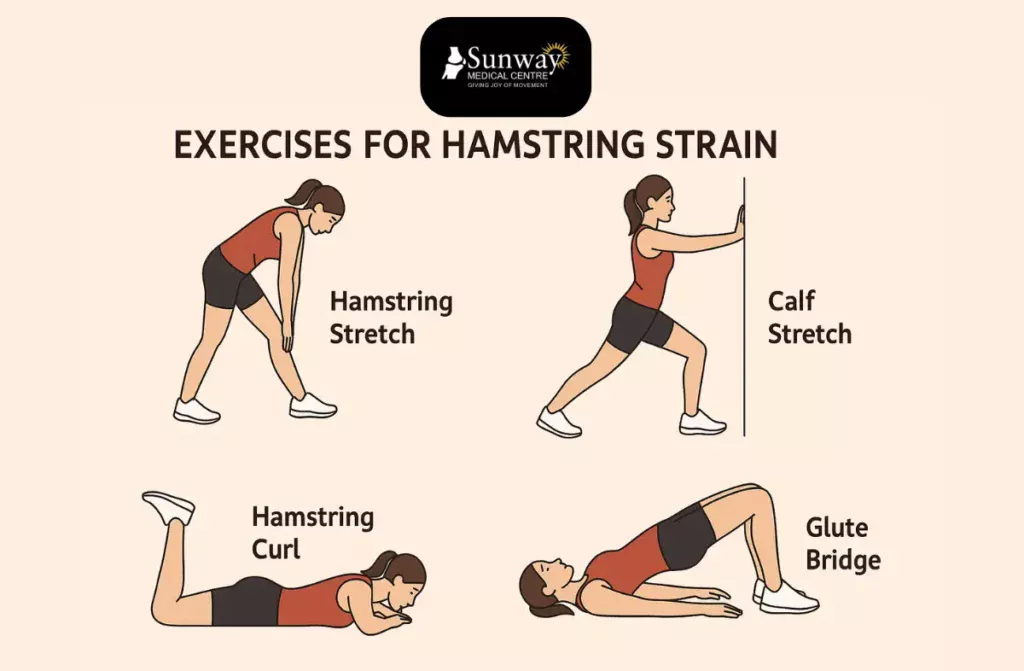Hamstring injuries are one of the most common muscular injuries among athletes and active individuals. Whether you’re a professional athlete or someone who stays active occasionally, understanding the right exercises for hamstring strain can be a game changer. Dr. Madan Mohan Reddy, a renowned specialist, shares his expertise to help you recover efficiently while avoiding future injuries. Let’s dive into this comprehensive guide.
Hamstring Strengthening Exercises
Strengthening exercises are essential for rebuilding muscle and preventing re-injury. Some recommended options include:
1. Hamstring Heel Digs
This beginner-friendly move activates your hamstring muscles without putting too much strain on them.
- Why it helps: Builds foundational strength and promotes circulation.
- Tip: Perform slowly and on a soft surface to avoid overactivation.
2. Seated Hamstring Stretch
Sit on a mat with one leg extended and the other bent inward. Lean forward gently toward the extended leg.
- Why it helps: Improves flexibility and reduces tension in the injured area.
- Tip: Hold for 15–30 seconds and don’t bounce; go only as far as is comfortable.
3. Standing Leg Curls
While standing, gently bend your knee and bring your heel toward your buttocks. Use a chair or wall for support.
- Why it helps: Engages hamstring muscles in a safe, controlled way.
- Tip: Do this slowly to avoid triggering sharp pain control is more important than height.
4. Bridge Pose
Lie on your back with your knees bent and feet resting flat on the ground. Lift your hips upward, squeezing your glutes.
- Why it helps: Strengthens the hamstrings, glutes, and lower back.
- Tip: Avoid over-arching the spine; focus on lifting through the hips with control.
5. Straight Leg Raises
Lie on your back, keeping one knee bent while the other leg stays straight.
- Why it helps: Builds strength in the thighs and core without stressing the hamstring.
- Tip: Keep your movements slow and stop if you feel any pulling in the back of your thigh.
6. Wall Hamstring Stretch
Lie on your back with your heel resting on a wall, leg extended straight up.
- Why it helps: Provides a passive, controlled stretch to improve mobility.
- Tip: Keep the other leg bent or flat on the floor for comfort.
7. Isometric Hamstring Contractions
While seated or lying down, press your heel into the floor or a towel without moving the leg.
- Why it helps: Activates the hamstring gently, rebuilding neuromuscular control.
- Tip: Hold for 5–10 seconds and repeat; avoid any jerky motion.
8. Step-Ups
Use a low, sturdy step or platform and slowly step up with one leg, then down.
- Why it helps: Encourages functional movement, improving strength and balance.
- Tip: Start with a low height; make sure you have something to hold for balance.
9. Resistance Band Hamstring Curl
Loop a resistance band around your ankle and a stable object. Curl your leg against the resistance.
- Why it helps: Adds progressive strength training as you recover.
- Tip: Use a light band to start and increase resistance gradually.
10. Foam Rolling (Self-Myofascial Release)
Roll the foam roller gently under your hamstring muscles to reduce tightness and improve blood flow.
- Why it helps: Eases muscle tension and promotes healing through increased circulation.
- Tip: Don’t roll directly on painful or swollen areasgo slow and avoid bony spots.

What are the Symptoms of a Hamstring Injury?
The symptoms of a hamstring strain include:
- Sudden pain at the back of the thigh.
- Swelling and bruising.
- Difficulty bearing weight on the injured leg.
- A popping sensation during the injury.
Recognizing these symptoms early is crucial. Prompt treatment and the right physical therapy for pulled hamstring can prevent the condition from worsening.
Causes of Hamstring Strains and Pulled Hamstrings
Hamstring injuries can occur due to several reasons, including:
- Overstretching during physical activity.
- Poor flexibility or weak muscles.
- Fatigue from overuse.
- Previous hamstring injuries.
Inadequate warm-up and improper form during exercises are also contributing factors. Addressing these issues through regular exercises for hamstring strain can help prevent recurrence.
Diagnosis of Hamstring Strains and Pulled Hamstrings
Diagnosing a hamstring strain involves:
- Physical examination: The doctor checks for tenderness, swelling, and bruising.
- Imaging tests: MRI or ultrasound scans may be used to determine the severity of the injury.
Once the diagnosis is complete, a tailored rehabilitation plan that includes physical therapy for pulled hamstring is developed. Accurate diagnosis ensures that the injury is treated effectively, reducing the risk of chronic issues.
Stretching Exercises for Hamstring Recovery
Stretching is a critical component of any recovery plan. Here are some effective stretches:
- Seated Hamstring Stretch:
- Sit on the floor with one leg stretched out and the other knee bent.
- Reach toward your toes, keeping your back straight.
- Hold for 20-30 seconds and switch sides.
- Standing Hamstring Stretch:
- Place one heel on a low bench or chair.
- Keep your leg straight and lean forward gently.
- Hold for 20 seconds on each leg.
These stretches help improve flexibility and reduce stiffness, promoting faster hamstring pull recovery. Stretching exercises are essential to ensure the success of physical therapy for hamstring injury. Adding dynamic stretches, such as leg swings, can further enhance the recovery process by improving circulation and preparing the muscles for activity.
Physical Therapy Exercises After Hamstring Strain
Physical therapy combines stretching and strengthening with advanced techniques.
Key Physical Therapy Movements:
- Step-ups:
- Use a low platform and step up with the injured leg.
- Step down slowly and repeat for 2 sets of 10-12 repetitions.
- Side-lying Leg Lifts:
- Lie on your side and raise your injured leg upward.
- Lower it back gently and repeat 15 times per set.
- Eccentric Hamstring Training:
- Sit on a resistance machine or partner-assisted setup.
- Focus on controlled lowering motions.
By incorporating these into your regimen, you’ll experience improved strength and stability, essential for hamstring pull recovery and physical therapy for pulled hamstring. These activities complement exercises for hamstring strain to ensure comprehensive recovery. Physical therapy sessions may also include massage and electrical stimulation to relieve pain and improve circulation.
Benefits of Exercises for Hamstring Strain
Rehabilitation exercises are a key part of physical therapy for pulled hamstring injuries. They help:
| Benefit | Description |
|---|---|
| Eases Muscle Tightness | Loosens tight hamstrings and reduces discomfort, especially after injury. |
| Increases Flexibility | Expands motion in the hips and knees for smoother, more comfortable movement. |
| Rebuilds Muscle Strength | Helps restore strength lost from inactivity, injury, or prolonged sitting. |
| Lowers Risk of Re-Injury | Stronger hamstrings are better equipped to handle physical demands safely. |
| Eases Lower Back Tension | Reduces pressure on the lower back by improving hamstring support. |
| Supports Better Posture | Encourages proper alignment and enhances body balance and control. |
| Enhances Sports Readiness | Improves strength and agility for a confident return to athletic activities. |
| Improves Blood Flow | Promotes circulation, which speeds up healing and lowers inflammation. |
| Lays Groundwork for Rehab | Builds essential strength for success in physical therapy or advanced rehab. |
Recovery and Prevention
Recovering from a hamstring injury takes time and patience. To ensure a complete recovery, follow these steps:
- Rest and Ice: Take breaks from physical activities and apply ice packs to reduce swelling.
- Compression and Elevation: Use compression wraps and elevate your leg to alleviate discomfort.
- Follow the Rehabilitation Plan: Stick to your prescribed exercises for physical therapy for hamstring injury consistently.
- Monitor Your Progress: Regularly assess your flexibility and strength to ensure you’re on track for recovery.
Preventing future injuries involves maintaining flexibility, warming up before activities, and performing regular exercises for hamstring strain to keep the muscles strong and resilient.
Conclusion
Recovering from a hamstring injury can be challenging, but with the right guidance and dedication, you can regain full function. By incorporating the outlined exercises for hamstring strain, you’ll strengthen your muscles, enhance flexibility, and prevent future injuries. As Dr. Madan Mohan Reddy emphasizes, consistent rehabilitation and professional guidance are keys to success.




